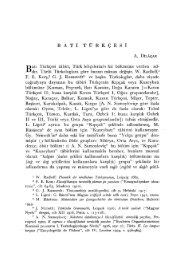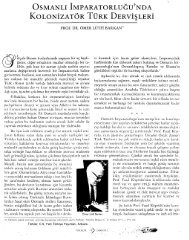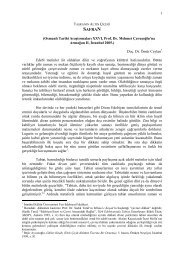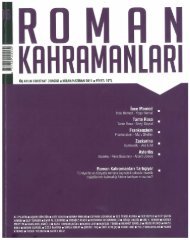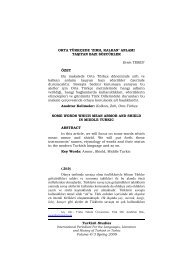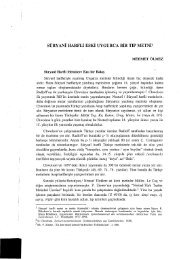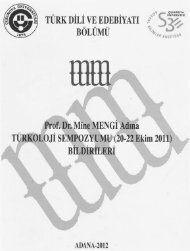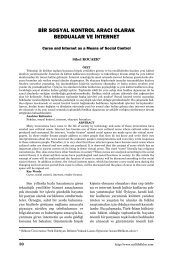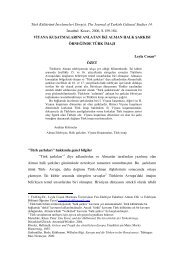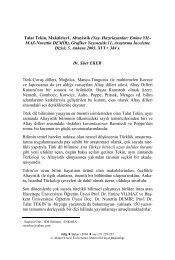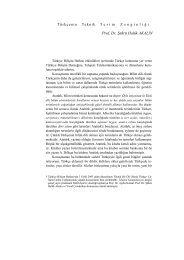Hll.IlbHble 6/11oiJa xaKaC06 [= Khakas national dishes] (Abakan 199
Hll.IlbHble 6/11oiJa xaKaC06 [= Khakas national dishes] (Abakan 199
Hll.IlbHble 6/11oiJa xaKaC06 [= Khakas national dishes] (Abakan 199
You also want an ePaper? Increase the reach of your titles
YUMPU automatically turns print PDFs into web optimized ePapers that Google loves.
FOL lA ORIENTAL lA<br />
VOL. 31 <strong>199</strong>5<br />
PL ISSN 0015-5675<br />
MAREK<br />
STACHOWSKI<br />
l<br />
i<br />
I<br />
l<br />
JJ<br />
ETYMOLOGICAL STUDIES ON KHAKAS FOOD NAMES<br />
The publication of a smalI, but very interesting book Haauo<br />
<strong>Hll</strong>.<strong>IlbHble</strong> 6/<strong>11oiJa</strong> <strong>xaKaC06</strong> [= <strong>Khakas</strong> <strong>national</strong> <strong>dishes</strong>] (<strong>Abakan</strong><br />
<strong>199</strong>4, 32p.) by V. Ja. Butanaev was an important stimulus for the<br />
present author to make a modest attempt at an etymological study<br />
on som~ food names presented there.<br />
asxyldym 'sour spice for soups' (But. 20, Nr. 4) < *askyltym <<br />
*ak'syltym (but see below) < *aksy ...•*iiksi > Ott. iiksi, Krim<br />
Kar. iiksi ...•iixsi 'sour' (ESTJa I 259; KRP 658, 672). - The<br />
main problem in this etymology is that iiksi 'sour' and iiksi- 'to<br />
become sour' are normally attested in Oghuz and Kipchak languages<br />
only, but not in Sibena. -.ef. also Bsk. iiskUtlm 'bittensh'<br />
...•iisk'ilt 'sounsh', Tat. iickUtlm ...•iickUt 'sounsh' ...•ac<br />
JcYlrym 'bittensh' (Sc. MI 115f.).- Since the Volga Tatars migrated<br />
eastwards as early as in the 17th century and their migration<br />
increased considerably after they had received special<br />
trade pnvileges in the second half of the 18th century (Kapp.<br />
35f.), by <strong>199</strong>0 over 27,000 Volga Tatars lived in different Sibenan<br />
colonies (Fors. 196), and they played an important role<br />
in tpe culturallife east of the Urals (Fors. 300; for Tat. influence<br />
in Middle Asia see also Bald. passim). Therefore, it seems
148<br />
quite legitimate to treat the Kh. word as a loan from Tat., maybe,<br />
connected with Tat. trade activities in the 18th and 19th centuries.<br />
However, in view of Kh. -sx- < *-sk- < *-k's- (cf. Kh.<br />
tasxax 'Regal (-brett/-fach)' < *taskak < *tak-cak, see StachM<br />
EChE), the modem Tat. form atkjlrym cannot possibly have<br />
been the direct source of Kh. asxyldym, because it would have<br />
yielded a form like *atxyldym rather (cf. Kh. xaratxaj 'swallow'<br />
with -ex-). Thus, the following treatment is plausible: Kh.<br />
asxyldym < Older TaL (l8th c.?) askjlrym « *aksyltym) ><br />
Modem Tat. atkjlrym.<br />
calbax 'fiat calce made of leaven and "ayran"-yoghurt' (But. 18,<br />
Nr. 9) < *jalmak < *jalma- « *jal- > Ott. jala- 'to lick') ><br />
Kirg. galma- 'to take into one's mouth, to eat greedily, to feed,<br />
to stuff'; cf. Trk.dial. jalma-c 'fodder made of flour and bran'<br />
(ESTJa IV 95). - Conceming Kh. -b- < *-m- see carba below.<br />
car ba, in: tarba ugrii 'meat soup with pearl barley' (But. 7, Nr.<br />
18). - The original meaning of tarba was *'minced meat',<br />
*'something minced' or the like, cf. Tuv. tarba 'Hacksel fUr<br />
Vieh' (> Yak. *tarba> barca '1.Zerstiickeln; 2.Schutt') <<br />
*jiirma < *jiir- 'to split, to chop' (StachM PEJ 110f.; Tekin<br />
175). -- Note the different reflexes of the suffix *-ma in tarba<br />
and in xyjma (see below). The reason for the different evolution<br />
of the origina1 *-m- lies in the phonetic position. As can be<br />
seen in Kh. talbax (see above) < *jalmak and Kh. tarba <<br />
*jiirma, the rule was: *-rllm- > -rllb-. This is the reason why<br />
we cannot accept the assumption that Sdk. both earba AJ oarba<br />
'barley' (with the word-initial diphthong ret1ecting Tu. *ii) and<br />
iirma AJ arma id. go back to Tu. arba (Fil. 75) < *iirpa [cf.<br />
Hungarian arpa id.]. Apart from the inner-Tu.evolution ([1]<br />
*jiirma> *jarma > *jarba > Kh. Tuv. tarba), we are faced<br />
with two different Tu. etyma, as far as the Selk. forms are concemed:<br />
[2a] *jiirma 'something minced' > *iirma (> Selk.<br />
iirma 'barley', Fil. 75) > *arma (> Setkoarma id., Fil. 75); [2b]<br />
*iirpa 'barley' [> Old Uig. arpa '1.Gerste, Gerstenk:orn; 2.Gersten-',<br />
UigWb. 3: 201] > *iirba [> Southern Setk. earba,oarba<br />
id., Fil. 75] > Kaca-Kh. arba id. Fil. 75 cites also "tuba arma"<br />
. after SIGF 320 where, however, no souree is given; in any<br />
case, no Tu. forms like arma can be found in ESTJa I 176f.<br />
(s.v. arpa) and Rass. LFf 155-158. This is why we have every<br />
reason to suspect that "tuba arYna" is a ghost-form and that<br />
Selk. earba and iirma cannot possibly reflect one and the same<br />
Tu. word arba. The j-m variants (Iike Brb. jarma, Kirg. garma<br />
'pearI barley') are clearly results of the semantic evolution of<br />
*jiirma and should not be connected with *arpa (contra Fil.<br />
113f.). - See also porca below.*)<br />
'ipak see Upak.<br />
Itpak 'brown bread' (But. 21, Nr. 6) -lpak 'bread' (KhR67b) =<br />
Chul. itvak - itpiik 'bread' (Bir. 34) = Tat. ikmiik id., Tat.dial.<br />
itmiik AJ uptok id: (Tum. 61,229) = Alt. otpok 'roll' (Tyd. 158),<br />
Leb.-Alt. iitpok 'bread' (Bask. 219) = Krim Tat. otmak 'bread'<br />
(Jank. 378) = att. iikmiik 'bread' = MTu. iitmiik AJ iipmiik AJ<br />
iipak 'bread' (MK Comp. 29. - Contra ESTJa I 254: "B CJIOBape<br />
M. KaIIIrapCKoro rrpHBO,IJ;HTC.sI JIHIIIbo}J;HacPopMaepmek") <<br />
*iipmiik < *iip- '1' > Tat. ipi, Bsk. iipiij 'bread' (ESTJa, 1.c.).<br />
- For ippiik as a Tu. loan in Kamass see Veen. 283 and Hel.<br />
TMV 70, Nr. 162. - Because of Tat. ipi, Bsk. iipiij < *iip-, the<br />
original word-medial cluster must have been *-pm-, not *-tm<br />
(contrary to Joki 138f.). - The labialization of the word-initial<br />
vowel results from the influence of the original *-p-: Alt. otpok<br />
(AJ utpok) < *Otmiik (> Krim Tat. otmiik) < *opmiik< *iip-mak.<br />
komacak 'flat cake made of unleavened dough with milk, spread<br />
with mi1k cream or fat and baked in ashes' (But. 17, Nr. 6) <<br />
*komiit (> Brb. kOmat 'roll' [Dm. 161], Uig.dial. komot AJ komat<br />
- kumiit 'bread baked in ashes' [Ten. 96]) < kom- AJ gom<br />
'to bury (in earth, ashes, etc.)' (Ten. 96).<br />
mirak 'kind of dumpling, stuffed with meat and onions [= Russ.<br />
permen]' (But. 19, Nr. 14) = Sh. piiriik 'pie [= Russ. pirog]'<br />
(RS 53 S.V. pirog) = Chu1. porak 'pie' (Bir. 55). - This word<br />
seems to be unknown in other Tu. languages of Siberia; for<br />
some (not very numerous) records from non-Siberian Tu. languages<br />
see ESTJa II 219 (the existence of att. boriik id. exc1udes<br />
the possibility of Slavic [cf. Russ. pirog] origin of the<br />
*) I am very much indebted to E. Helimski for his comments and the discussion<br />
on this and some other words in this paper.<br />
149
~<br />
150<br />
Tu. word), where, however, the Siberian data are lacking; cf.<br />
also TMEN II 331, Nr. 781: "Da das Wort innerhalb der Ttirksprachen<br />
nur in einem begrenzten Gebiet erscheint (fehlt u.a.<br />
siidsibir., jak.) [... l". - It is generally accepted that m- occurs<br />
sometimes in place of b- in words with a nasal as the following<br />
eon sonant (as in biin ""miin '1', etc.), but there is no nasal in<br />
the second syllable of miriik. This phenomenon recurs over and<br />
over in different Tu. languages, as it seems, rather chaotically,<br />
cf. for instance Siberian Tat. mirtiik = Literary Tat. birtiik 'sick,<br />
disable' (Tum. 152), Brb. mic [-c = -ts] "" miG 'stove, oven'<br />
(Dm. 165) < Russ. pee' id., Leb.-Alt. mOru 'wolf' (Bask. 178)<br />
< *boro (StachM GJV 91, § 22.4), Leb.-Alt. motik 'cock'<br />
(Bask. 178) < Russ. petux id., Ott. me§e 'Eiche' = Anatolian<br />
Trk.dial. me§e id. < Pers. bisa 'forest, wood' (Pom. 110), Otto<br />
bahane 'Vorwand, Scheingrund' = Anatolian Trk.dial. mahana<br />
id. < Pers. bahana id. (Pom. 95) and so on; for the word-medial<br />
m < b d. also Ott. (1591) segmen 'Hundewmer, Janitschar' =<br />
Anatolian Trk.dia1. segmen id. < Pers. sag-ban 'dog-keeper'<br />
(Stach. PL V 101, Nr. 490; Pom. 117); see also potxy and tamax<br />
(in this study) and Hitch 138f. The p-/b- > m- change cannot<br />
be explained here but the existence of the b- "" m- alternation<br />
itself is evident. - Another difference between the Kh.<br />
word miriik and itscounterparts in the other Tu. languages lies<br />
in the vowel ofthe [Irst syllable. Before continuing this reflection,<br />
let us take a look at etymologies proposed so far. - One<br />
finds four etymologies of boriik in ESTJa II 219: [1] < bor- ....,<br />
bur- 'to fold, to pleat, to put/stick/pull together' [= Ott. bilz- 'to<br />
tie, to pull together'] (L. Z. Budagov); [2] < Pers. (J. Th. Zenker);<br />
[3] cognate with bork 'cap', bort- 'to swell' (M. Rasanen);<br />
[4] < buru- 'to cover, to wrap up' (G. J. Ramstedt). E. V.<br />
Sevortjan accepts Budagov's etymology as the most reliable.<br />
- Now, the problem arises, how -i- in Kh. miriik can best be<br />
explained. In ESTJil II 219, the phonetic variants bor- and burare<br />
given side by side as equal stems, but the fact is that bordoes<br />
not exist except in one Ott. record: boz- (Zenker), alongside<br />
with the usual buz- (ESTJa II 294). The reduction of il in<br />
the Tat. and Bsk. form blir- (ESTJa, 1.c.) also points to an<br />
original u, not o (see Berta 182:Volga Kipchak *burul-; Berta<br />
GT 112: *0 > u, *u > li). The assumption that biir- is the original<br />
variant fits very well to Kh. initial mi-o It seems, however,<br />
somewhat strange to accept also the consequence, Le. the fact,<br />
that Kh. is the only Tu. language which preserved the original<br />
vowel (by the way, in a delabialized form -i-, not -u-), whereas<br />
aU the other Tu. languages changed it to -0-. The opposite<br />
change appears more likely. - This is why we would rather<br />
accept M. Rasanen's suggestion. The verb bor(u)t- < *bor(u)<br />
has several meanings in different Tu. languages, such as 'to<br />
swell' (Tat.), 'to swell in water' (Trk. dialects), 'to absorb water'<br />
(Kklp.), '[intrans.] to cookjboil slight1y' (Trk. dialects), see<br />
ESTJa II 224. Pies and dumplings do really absorb water and<br />
"swell". This. would mean that -i- < *-u- < *-0- in Kh. is secondary<br />
in comparison with -0- of the other Tu. languages.<br />
mun 'soup, broth' (But. 24, Nr. 2) = Tuv. Tof. Alt. Chu1. Sh. mun<br />
id. = Yak. mun id., Dolg. min id. (StachM DW 179) ""min id.<br />
(Fuj. 267) = Leb. mun ""min id. (Bask. 177) = MTu. miln ....,<br />
mun"" bun 'soup, noodles' (MK Comp. 120). - Neither the attempts<br />
to treat Tu. mun ""bun as a loanword from Proto-Sam.<br />
*wen3 nor the assumption of Proto-Sam. *wen3 being loaned<br />
from Tu. are satisfactory due to phonetic shortcomings. If we<br />
accept the Tu. etymology of Proto-Sam. *wen3, the Tu. bu- ><br />
Proto-Sam. we- change remains inexplicable, "because PS [=<br />
Proto-Sam.] had both wii- (cf. wat 'water') and pu- (cf. pu- 'to<br />
spawn')" (Róna-Tas 746, Nr. 19). If we treat the Tu. word as a<br />
loan from Proto-Sam., we can explain the dropping of the origina1<br />
word-final vowel in *wen3, but the different treatment of<br />
*-n in *wen3 (> Tu. -n) and in Tu. *kon 'sheep' (> Tu. -j(u)n)<br />
remains unclear (for *kon see Róna-Tas747, Nr. 27). As E.<br />
Helimski right1y says, "it would be much better to see here an<br />
accidental and, besides, only partial resemblance" (Hel. Nr.<br />
12). Consequent1y, A. 1. Jo1O's idea of Chin. origin of both the<br />
Sam. and the Tu. word still deserves our attention (Joki 229:<br />
[1] Tu. min < Chin. *mjiin; [2] Chin. compound *miiin + *iiik<br />
'fluid, juice' > *min-jii > *minii > Sam.) ..<br />
naspax 'pearl barley mixed with boiled potatoes Ol' fat' (But. 17,<br />
Nr. 5) = Tuv. caspak id. (ibid.) = Tat.dial. jasmak 'lenti1'<br />
(ESTJa IV 154, where the Kh. and Tuv. examples are lacking).<br />
151
152<br />
Cf. Sal.jasmux 'pea' (ESTJa N 154) = Old Uig.jasymuk 'millet'<br />
(DTS 245), etc. - Of the two etymological models ([1] <<br />
jas- 'to make flat, to flatten'; [2] < jasy 'flat') presented in<br />
ESTJa IV 154,only [1] can be taken into consideration here,<br />
because -mak produces deverbal nouns. As far as -muk words<br />
are concerned, the second proposal cannot be exeluded. - The<br />
Tuv. variant contributes to the reconstruction of the relative<br />
chronology of the Tuv. phonetic evolution: as -s- developed<br />
from -s- under the influence of the initial c-, the latter must<br />
have developed < j- earlier than -s- became -s-, Le. (1) j- > c-;<br />
(2) *c-s > c-s (but see below *jiispiik). Another chronological<br />
chain\ can be reconstructed for Kh. naspax: < *nasmak < *jasmak<br />
(= Tat.dial. jasmak, see above), Le. (1) *j (-m) > n (-m);<br />
(2) *-(s)m- > -(sJp-o - Because of semantic differences, it is<br />
not quite elear whether Kam. nespiikf '" nespiikc '" ndpiik<br />
'dick, groB' also belongs to the same word family. Joki 243<br />
tried to connect it with Salbin-Koyb. t'ys 'dick' and the like,<br />
but in that case the identification of the second syllable of the<br />
Kam. word with Tu. *-miik is impossible because, *-miik is a<br />
deverbal formative. Moreover, the word t'ys seems to have no<br />
counterparts in the other Tu. languages so that Joki (Le.) says<br />
finally: "[ ... ] die Etymologie ist also fraglich". Phonetically,<br />
the Kam. word can be traced back to Tu. *jiispiik « *jasmak,<br />
with the palatalization resulting from the influence of *j-)<br />
which, possibly, was a phonetic variant of Old Tuv. *jaspak<br />
(d. first of all Kam. nespiikC). Unfortunately, no direct trace of<br />
*jiispiik could be found in the Tu. languages of Siberia.<br />
nymyrt 'bird cherries, mixed with boiled milk cream or melted<br />
butter and groats' (But. 21, Nr. 8-9) [= Chul.jomurt (Bir. 35) '"<br />
cumurt (Bir. 74) 'bird cherry', Sh. nybyrt id. (SRS 34b) = Siberian<br />
Tat. jomyrt (Tum. 82) '" jumrut (Tum. 86) '" somrot<br />
(Tum. 251) id., Literary Tat. somyrt id.] < *jymyrt < *jumyrt «<br />
*jomyrt) *'globule, something globular (?)' > *jumyrtka > Old<br />
Uig. jumur(l{U 'Ei' (Zieme BSU 247a), Trkm. jumurtga 'egg',<br />
Ottojumurta id., Tuv. curga id. - One finds a lot of phonetic<br />
variants of *jumyrtka in ESTJa IV 250f. (d. also Kh. nymyrxa<br />
'egg'), but *jumyrt itself is missing there. See also Joki NT 57,<br />
where Tu. jumurt is connected with Ur. *~'6me > FL tuomi<br />
'Traubenkirschbaum, Ahlbaum, Prunus padus' .<br />
orama 'sour milk cream' (But. 9, Nr. 7) '" ori1)mii '" uru1)mii '"<br />
urugmii 'cream, sour cream, milk film' (Rass. MBZ 37) =<br />
Sag.-Kh. urugmii 'saure Sahne' (Radl. I 1834) '" urumii 'Rahm,<br />
Sahne, saure Sahne' (ibid. 1834) '" orul)miik 'cream' (SRS<br />
133a) = Tuv. Tof._oriimii, Alt. oromo 'milk film' (Rass. MBZ<br />
27) = Yak. orumii '" urumii 'Rahm, Haut auf Fltissigkeiten'<br />
(Kal. MEJ 19) < Mo. orumii id. (Kal. MEJ 19; Rass. MBZ 27).<br />
- The -g-/-f)- variants occur only in Kh. and Sh. It was probably<br />
a southern dialect of Kh. (or Sh.?) which inserted the unetymological-g-/-1)-<br />
before the original -m- of the Mo. etymon;<br />
cf. Kh. (Beltir) porol)maj 'Sperling, Spatz' < *poromaj <<br />
*porobaj < Russ. vorobej id. (StachM ECh E S.V. porata)). We<br />
have at any rate to distinguish between Kh. oriimii and ori1)mii<br />
,., uru1)mii '" urugmii.<br />
poga see poza.<br />
porca 'dried meat, mixed with cooked groats' (But. 3, Nr. 3) ,=<br />
Kzk. boda, Yak. puorsa 'Trockenfleisch, -fisch', ultimately <<br />
Sam. *por-sd (Janh. passim). - For the connections between<br />
porca and carba see aIso StachM PEJ 110f.<br />
potxy 'dish made of cooked grains or groats, soup ofpearl barley'<br />
(But. 8-10, 14-16, 19, 21-23) '" Kaca-Kh. (18thfl9th century)<br />
botxu id. (Sp. 139) = Alt. botko '" potko '" motka id. (ESTJa II<br />
201) '" Leb.-Alt. motka id. (Bask. 178) [for m- instead of b-, p<br />
see miriik above] = Sh. motka 'Brei aus Gerstenmehl mit saurer<br />
Sahne' (Joki 104) = Brb. pótka 'soup of pearl barley' (Dm.<br />
177) = Siberian Tat. potka id. (Tum. l76b). - Etym.: <<br />
*bot(a)- '" *but(a)- *'to stir' (ESTJa II 201). - The word is<br />
relatively well attested in all Tu.language groups with the exception<br />
of the extreme East and North (Tuv., Tof., Yak. and<br />
Dolg.). Yenisei seems to be its eastern border. This fact points<br />
possibly to a Western channel of borrowing (in all probability,<br />
through Brb. and Siberian Tat. dialects, see the data above).<br />
As long as *-ky (instead of *-ka) occurs in Kh. only (d. also<br />
Yale butugas 'Griitze' < *butukac < *butka-c; see Kal. IM<br />
110; StachM GJV 116, § 35.2), it would be plausible to speak<br />
of the -a> -y change rather than of two different suffIXes (con-<br />
153
154<br />
tra ESTJa II 201: *hot- + *-ka, *hot- + *-ky), even more so if<br />
potxy ~ hotxu is (in view of its geographical distribution, see<br />
above) an inner Tu. loanword in Kh., which indicates to -a as<br />
the original final vowel. - However, the reconstructed stem<br />
*hot(a)- ~ *hut(a)- along with its meaning *'to stir' (ESTJa II<br />
201) are purely hypothetical, so that a borrowing from a non<br />
Tu. source cannot be exc1uded either.<br />
poza ~ poga. - The precise meaning of these words is unc1ear,<br />
cf. poza 'XMeJIbHOHHanHTOKl= alcoholic beverage]' (But. 25,<br />
Nr. 6), poga '6ap)J;a [= distillery refuse, dregs]' (But. 26); poza<br />
=poga 'dregs' (KhR 155, 159). - The ultimate source of both<br />
words seems to be Pers. boza 'rice beer' > Tu. boza > [a] Kh.<br />
poza; [b] Mo. hoga (Vlad. 332, Nr. 8) ~ bogo (Clark 40) > Kh.<br />
poga. -- The opposite loan direction (Le. Pers. < Tu.) would,<br />
however, also be possible, but poza has no unequivocal et y<br />
mology on the Tu. ground. For a discussion (without any solution)<br />
see TMEN II 337-341. - In any case, the Kh. form poga<br />
is (because of -g-) a loan from Mo.<br />
porsax 'a kind of pastry made of milk cream, milk, fat and eggs'<br />
(But. 18, Nr. 10) = Alt. burzak ~ borsok, Kirg. borsok 'little<br />
cake baked in sheep fat', etc. (ESTJa II 22) < bagyrsak > Ott.<br />
bagyrsak"'" bayrsak 'entrails, guts' (ib.). - It is not quite elear<br />
which type of food exactly made the semantic change from<br />
'entrails' to 'pastry, cake' possible. It may have been a kind of<br />
guts stuffed with paste, d. Fr. pfite, Engl. paste, pasta, pastry,<br />
Ott. pasta.<br />
tamax 'food, dish', as in: ax tamax (But. 7f.) 'milk food, dairy<br />
products'; as-tamax (KhR 33 s.v. as) 'food (stuffs)'. - In all<br />
likelihood, the same as Kh. tabax 'l.plate, bowl; 2.food, dish'<br />
[cf. KhR 21lb: tabax 'TapeJIKa, 6JIIO)J;O';RKh 65a: 6mooo (=<br />
KymaHbe)'[ ... ] as-tamax'], ultimately Tat.dial.<br />
tiigiirmiit 'wheel' (ESTJa III 172), Brb. tiigiirek 'round' (Tum.<br />
206), Siberian Tat. tigiireek 'wheel' (Tum. 209), Alt. tiigiirik<br />
'round; cirele' (RAS 267a); cf. GId Uig. tiigr-ik-lii- « *tiigirik-lii-)<br />
'to surround' (ESTJa III 172). - Kh. tiirpiik 'round' is<br />
either the next step in the phonetic evolution of Kh. tartpiik or<br />
another morphological form « *tiigir-, not < *tiigir-t-). For the<br />
*iigi > a change cf. also Kh. algiik 'biegsam ' < *iigil-Ciik <<br />
*iigil- > Kh. al- osich biegen' (StachM EChE). - The exact<br />
phonetic relation between Tuv. darbiik 'cirele' and Tuv. togiirik<br />
'round' remains undear. -. ChuI. tarmiit 'iron stove' (BiL<br />
63) is probably another derivative « *tiigirmiic) of this verb;<br />
the change of meaning is possibly due to the round form of traditional<br />
iron stoves.<br />
tom, in: tom xalas 'a kind of roll of wheat f)our' (Bul. 18, Nr. 12).<br />
- The second component of the compound is etymologically<br />
elear (see below xalas) but the first is not. V. Ja. Butanaev<br />
(1.c.) refers to Mahmiid al-KasyarI's item top in DTS 575: 'KYrnaHbe,<br />
npHfOTOBJI5IeMOeH3 TIIneHMl.J;bI li OBC5lHOHMYKM'<br />
(should this word be identified with [MK Comp. 197] top<br />
'boiled wheat'?), but it does not appear very convincing because<br />
of different fina] consonants. See also MK Comp. 195<br />
which al·-Kasyari interprets as a contraction < topyk;<br />
the editors of MK Comp. rightly put a "sic" to this interpretation;<br />
top is the original base of numerous derivatives, such as<br />
*topyk, see e.g. StachM GJV 83, § 16.6, with further refer-<br />
top 'ball',<br />
1<br />
155
156<br />
ences. - We are rathel' inclined to connect Kh. tom with Uig.<br />
dial. tom 'round' (Ten. 168), cf. especially the usage of the<br />
word in the Uig.diaJ. syntagma tom jaY'}Kl1p B KOMKax'= 'fat<br />
in (round) lumps' (op. ciL). - Three problems arise in this<br />
contexL In the first place, one may ask if there actually exists<br />
no connection between (Kh.) tom 'round' and (MK) top 'bali'.<br />
The question is quite legitimate, because the meanings and the<br />
phonetic fotms show a great resemblance, especially if one<br />
considers the shortening of long vowels in Kh. which enables<br />
us to posit hypothetically an older Kh. form *tom. Now, the<br />
furthel' analysis is possible due to Kh. gerunds like tap < *tabyp<br />
< tap- 'to find', sap < *sab-yp < sap- 'to strike, to hit' (Iskh.<br />
26). If Kh. a < *aby, then possibly Kh. o < *oby (Ol' *oby),<br />
which means that Kh. tom may go back to *tom < *tobym <<br />
*topym, and the latter is then a derivative < *top in the same<br />
way as *topyk. - The difference between the reflex of *tobym<br />
and that of *tabyp is that tom has a short vowel and tap a long<br />
one. This feature seems to point to a different chronology of<br />
both formations. In his lecture on the analogy in the Turkic languages<br />
(Berlin, Autumn <strong>199</strong>4), Professor A. M. Scerbak (SL<br />
Petersburg) suggested that the so-called Kh. locative suffix<br />
with directive function (-ta) is in reality only secondarily identical<br />
with the actuallocative suffix -ta and that it goes back to<br />
*ta < *taba « tap-a, which was used as a directive postposition<br />
in Old Tu.). The shortening of (*tobym » *tom > tom is<br />
then parallel to that of (*taba » *ta > ta, and both tom and -ta<br />
belong to an older layer, whereas verbal forms like tap and sap<br />
belong to a younger one. - Another question concerns the relation<br />
between (Old ?) Kh. *t6m and Yak. *tuom in tuomta<br />
'einen Knoten machen' (StachM GJV 77, § 13.5). At first<br />
sight, *tom and *tuom seem to fit perfectly to the well-known<br />
equation: Yak. uo = Gid Yak. / Proto-Tu. *6. The problem is<br />
that a derivative like *t6m-la- would in any case yield *tuomnii-<br />
in Yak., not the really existing tuom-tii-. There is only one<br />
possibility to explain a combination "voiced consonant (A) +<br />
voiceless consonant (B)" in Yak.: (B) became voiceless under<br />
the influence of another voiceless consonant which stood originally<br />
between (A) and (B). That is why Yak. tuomta- is to be<br />
traced back to *t6mkta- < *t6mukta- < *t6mukla- < *t6muk,<br />
and the latter goes back to *topyk or is a secondary derivative <<br />
*tom [= (GId ?) Kh. *t6m]. - The third problem to be mentioned<br />
here is the existence of Kh.dial. (Radl. III 1234: Kaca;<br />
KhR 23lb) tom 'medicine, medicament' and Eastem Tu.<br />
(Radl. III 1234) tom 'dick, dickfliissig (hauptsachlich von Drogen<br />
gesagt)'. It appears to us quite plausible to accept a seman-·<br />
tic evolution *'something round, balI' to *'pill, tablet' and further<br />
to 'medicine (generally)'. This would at the same time<br />
mean that tom in the syntagma tom xalas may be interpreted in<br />
its original meaning as *' something round, balI', so that tom<br />
xalas means literally 'round roll'. It is hard to say whether the<br />
Eastem Tu. meaning 'thick (-flowing)' is a next step in the<br />
same sernantic evolution, e.g. 'medicine (generally)' > *'syrup'<br />
> 'thick'. - An interesting conjecture was proposed by E.<br />
Helimski who thinks that the whole phrase tom xalas is a Kh.<br />
equivalent of Russ. * mOMcKuu lWllat( 'xalas-roll/loaf of<br />
Tomsk'. Really, the older Kh. foml of the town name Tomsk<br />
was Tom (KhR 346a), and *moMcKuu lWllat(fits the Russ. pattern<br />
of naming cakes and loafs quite well (cf .. mYllbcKuU npJl<br />
HUK, PUJlCCKUU X/le6). But it is, regretfully, not elear if there ever<br />
existed a *mOMcKuuKMat(. Another problem is the absence<br />
of the possessive suffix (xalas, not xalazy), but an analogy can<br />
perhaps be found in phrases like Kh. xakas kizi '<strong>Khakas</strong>' , tadar<br />
kizi 'Tatar' (KhR 78b), although this analogy is not quite reliable<br />
(formations like kizi-zi may easily lead to haplology [kizizi<br />
> kizi] or phonetic changes like the loss of the middle syllable<br />
in a three-syllabic word [kizizi > *kizzi] and next to the facilitation<br />
of the pronunciation of the unusual geminate -zz- [*kizzi ><br />
kizi]; nothing like this could occur in xalazy). A further problem<br />
is why *mOMcKuu (Kallalf)did not yield *tomskaj (xalas)<br />
rather than tom (xalas).<br />
uyba 'blend of ground roots and barley, used as an ingredient for<br />
soups or milk foods' (BuL 20, Nr. 3) < *ugma < *ug- > Kh. uy<br />
'to rumple, to crumple' = ChuJ. ug- 'to break' (Bir. 67), Tuv.<br />
ug- 'to crush, to break'. - The verb *ug_· seems to be unknown<br />
from other Tu. languages of Siberia (cf. ESTJa I 401<br />
where Kh. and Tuv. verbs are oniy cited). - The Kh. meaning<br />
157
158<br />
'to rumple' is - according to the data in ESTJa I 402 - probably<br />
secondary, the original meaning apparently being *'to rub'.<br />
- The voiceless -k- in Uzb.dial. ukala- 'to pulverize, to grind'<br />
(ESTJa 1204) results from a long consonant in *ukkala- < *ugkala-<br />
< *ug-.<br />
ugra 'soup' (But. 7, Nr. 18) = Sag.-Kh. iigra ~ iirgii id. (Pat. SD<br />
37) = Leb.-Alt. iirga id. (Bask. 219) < *iigra « *iigiira [><br />
Koyb.-Kh. iigiira id.1 < *iigiir- *'to rub, to crush') > Gid Uig.<br />
iigra 'Brei' (Zieme BSU 241b) = Tat. ojra 'Graupensuppe'<br />
(Schon. 248), Kar.LH iwre 'Karna, kasza' (KRP 192b) = Yak.<br />
iiora id. (StachM GJV 133, § 41.3).<br />
xalas 'a kind of roll Ol' small round 10af' (see above tom) < Russ.<br />
kalac id. (> Sh. Alt. kalas id., Brb. kalac id.) > kalac-ik, Dimin.<br />
(> Tuv. kalacyk id., Yak. xaliicyk id., Dol. kaliicyk id.).<br />
xyjrna 'a kind of sausage, stuffed with minced meat, horse fat,<br />
onions and pepper' (But. 6, Nr. 16) < *kyjma « *kyj- *'to<br />
chop, to mince, to hack'). - Note the different reflexes of the<br />
suffix *-ma in xyjma and in carba (see above). - Concerning<br />
the popularity of food names with *-ma in the Tu. languages<br />
cf. the possibility to attach this suffix even to foreign and nominal<br />
stems, as in Anatolian Trk.dial. muxlama 'eine Speise, die<br />
zubereitet wird, indem man Kase im Fett brat' < Ar. muqla<br />
'Pupille, Augapfel' (BUis.44, Nr. 11).<br />
Abbreviations<br />
Alt. = Altaian; Ar. = Arabie; Brb. = Baraba; Bsk. = Bashkir; Chin. = Chinese;<br />
Chul. = Chulym; dial. = dialect, dialeetal; Dol. = Dolgan; Engl. = English; Fi •<br />
= Finnish; Fr. = Freneh; Kam. = Kamass; Kar. = Karaim (H - Halicz; L <br />
Luck); Kh. = <strong>Khakas</strong>; Kirg. = Kirghiz; Kklp. = Karakalpak; Koyb. = Koybal;<br />
Kzk. = Kazakh; Leb. = Lebed; Mo. = Mongolie; MTu. Middle Turkic; Otto =<br />
OUoman- Turkish; Pers. = Persian; Russ. = Russian; Sag. = Sagay; Sal. =<br />
Salar; Sam. = Samoyedie; Selk. = Selkup; Sh. = Shor; Tat. = Tatar; Tof. =<br />
Tofalar; Trk. = Turkish; Trkm. = Turkmen; Tu. = Turkic; Tuv. = Tuvinian;<br />
Uig. = Uighur; Ur. = Uralic; lJzb. = Uzbek; Yak. = Yakut.<br />
References<br />
Bald. = Baldauf, 1.: Tatarismus in Mittelasien. Das tatarische Vorbild in der<br />
Entwicklung der uzbekischen Sprache. - Laut, J. P. / Rohrborn, K. (eds):<br />
Spraeh- und Kulturkontakte der tiirkisehen Volker (= Veroffentlichungen<br />
der Societas Uralo-Altaica 37), Wiesbaden <strong>199</strong>3: 13-49.<br />
Bask. = Baskakov, N. A.: Dialekt lebedinskikh tatar-calkancev (kuu-kizi).<br />
Grammaticeskij ocerk, teksty, perevody, slovar', Moskva 1985, 233p.<br />
Berta = Berta, A.: Lautgeschichte der tatarischen Dialekte (= Studia Uralo-AItaica<br />
31), Szeged 1989, 304p.<br />
Berta GT = Berta, A.: Graphische Probierne des Tatarisehen. - O. Werner<br />
(ed.): Probleme der Graphie, Tiibingen <strong>199</strong>3: 107-120.<br />
Bir. = Birjukovic, R. M.: Leksika culymsko-tjurkskogo jazyka. Posobie k speekursu,<br />
Saratov 1984, 88p.<br />
BHis. = Blasing, u.: Armenisch - Tiirkisch. Etymologisehe Betraehtungen ausgehend<br />
von Materialien aus dem Hem~ingebiet nebst einigen Anmerkungen<br />
zum Armenisehen, insbesondere dem Hem~indialekt (= Dutch Studies in<br />
Armenian Language and Literature 4), Amsterdam <strong>199</strong>5, 207p.<br />
But. = Butanaev, V. Ja.: Xooraj as-tamaxtary. Nacionarnye bijuda khakasov,<br />
<strong>Abakan</strong> <strong>199</strong>4, 32p.<br />
Clark = Clark, L. V.: Turkic loanwords in Mongol, I: The treatment of noninitial<br />
s, z, s, c. - CAl 24 (1980): 36-59.<br />
DKh = Patacakova, D. F. (ed.): Dialekty khakasskogo jazyka. Ocerki imaterialy,<br />
<strong>Abakan</strong> 1973, 158p.<br />
Dm. = Dmitrieva, L. V.: Jazyk barabinskikh tatar (Materialy i issledovanija),<br />
Leningrad 1981, 224p.<br />
DTS = Nadeljaev, V. M. et al. (ed.): Drevnetjurkskij slovar', Leningrad 1969,<br />
XXXVIII + 676p.<br />
ESTJa = Sevortjan, E. V.: Etimologiceskij slovar' tjurkskikhjazykov, Moskva,<br />
vol. I (vowels): 1974, 767p.; vol. II ("b"): 1978, 349p.; vol. III ("v, g, d"):<br />
1980, 395p.; vol. IV ("g, Z,j") [& Levitskaja, L. S.]: 1989, 293p.<br />
Fil. = Filippova, T. M.: Tjurkskie zaimstvovanija v serkupskom jazyke, Novosibirsk<br />
<strong>199</strong>1, 268p. [unpublished typescript].<br />
Fors. = Forsyth, J.: A history oj the peoples oj Siberia. Russian North Asian<br />
fi colony 1581-<strong>199</strong>0, Cambridge <strong>199</strong>2, XX + 455p.<br />
.1·...•<br />
>, . Fuj. Hel. - = Gengogaku Fujishiro, Helimski, S.: E.: Materials Samoyedic Linguistie of the 10ans Researeh Dolgan in Turkic: language eheck-list in Taymyr of etymologies 261-284. [in Japanese]. [in<br />
, press].<br />
~. Hel. TMV = Helimski, E.: Two Mator-Taigi-Karagas vocabularies from the<br />
18th century. -JSFOu 81 (1987): 49-132.<br />
Hitch = Hitch, D.: Old Turkic b and p. - Sagaster, K. / Eimer, H. (eds): Religious<br />
and lay symbolism in the Altaie world and other papers<br />
Wiesbaden 1989: 130-146.<br />
(PlAC 27),<br />
159
160<br />
Iskh. = lskhakov, F. G.: KJwkasskij jazyk. Kratkij ocerk po fonetike, <strong>Abakan</strong><br />
1956, 75p.<br />
Janh. = Janhunen, 1.: "Porsa" - a Siberian cultural tenn. - StO 47 (1977): 103<br />
107.<br />
.Jank. = Jankowski, H.: Gramatyka jezyka krymskotatarskiego, P()Znan <strong>199</strong>2,<br />
XVIIl + 455p.<br />
.Joki = Joki, A.: Die Lehnworter des Sajansamojedisehen (= MSFOu 103), Helsinki<br />
1952, 395p.<br />
.Joki NT = loki, A.: Die altaische Einwirkung auf die uralische Naturterminologie.<br />
- TUBA 4 (1980): 57-60.<br />
Kal. IM = Kaluzynski, S.: Issledovanija po morfologii jakutskogo jazyka, I. <br />
RO 31/2 (1968): 107-119.<br />
Kal. ME.J = Kaluzynski, S.: Mongolisehe Elemente in der jakutisehen Spraehe,<br />
Warszawa<br />
1961, 17Op.<br />
Kapp. = Kappeler, A: Russland ais Vielvolkerreieh. Entstehung - Gesehiehte<br />
- Zerfal!, Mtinchen <strong>199</strong>32, 395p.<br />
KhR = Baskakov, N. Al Inkizekova-Grekul, A I.: <strong>Khakas</strong>sko-russkij slovar',<br />
Moskva 1953, 487p.<br />
KRP = Baskakov, N. A I Zajaczkowski, A I Szapszal, S.: Slownik karaimskorosyjsko-polski.<br />
Karaimsko-russko-porskij slovar', Moskva 1974, 688p.<br />
MK Comp. = Dankoff, R.I Kelly, 1. (OOs):Mahmiid al-Kii!rprf - Compendium<br />
of the Turkie dialeets (Dfwiin Lu'}l'itat Turk), Part III (= Sources of Oriental<br />
Languages and Literatures 7), Harvard 1985.<br />
Pat. SD = Patacakova, D. F.: Sagajskij dialekt. - DKh 28-48.<br />
Pom, = Pomorska, M.: New-Persian loanwords in Anatolian-Turkish dialects<br />
(1). -- Studia Tureologiea Craeoviensia l (<strong>199</strong>5): 91-123.<br />
Pr J = Zeszyty Naukowe Uniwersytetu Jagiellonskiego. Prace Jezykoznawcze,<br />
Kraków.<br />
Radl. = Radloff, W.: Versueh eines Worterbuches der Tiirk-Dialecte, St.-Petersburg<br />
1893-1905, vol. I-IV.<br />
RAS = Baskakov, N. A (ed.): Russko-altajskij slovar', Moskva 1964, XXXIV<br />
+ 875p.<br />
Rass. FL T = Rassadin, V. I.: Fonetika i leksika tofalarskogo jazyka, Ulan-Ude<br />
1971,251p.<br />
Rass. MBZ = Rassadin, V. 1.: Mongolo-burjatskie zaimstvovanija v sibirskikh<br />
tjurkskikh jazykakh, Moskva 1980, 115p.<br />
RKh = Cankov, D. I.: Russko-khakasskij slovar', Moskva 1961, 967p.<br />
Róna-Tas = Róna-Tas, A.: A Turkic influence on the Uralic languages. <br />
Sinor, D. (ed.): The Uralie languages. Deseription, history andforeign influenees,<br />
Leiden et al. 1988: 742-780.<br />
RS = [author?] Russko-sorskij slovar', Novosibirsk 1940, 97p.<br />
SC. MI = Scerbak, A M.: Ocerki po sravniternoj morfologii tjurkskikhjazykov<br />
([mja), Leningrad 1977, 192p.<br />
Schon. = Schonig, C.: Bemerkungen zur Lautgruppe oy in der tatarischen<br />
Schriftsprache. - Tiirk Kiiltiirii Ara~tlrmalarl 30/1-2 [= Prof. Dr. Ahmet Temir'e<br />
Armagan] (<strong>199</strong>2): 243-250.<br />
Sp. = Spasskij, G. 1.: Slovar' jazyka, upotrebljaemogo kizircami, kaCincami i<br />
sagajcami, sobrannyj v 1804 godu [with comments by D. F. Patacakova]. <br />
DKh 136-156.<br />
SRS = Kurpesko-TannagaSeva, N. N.I Aponkin, F. Ja.: Sorsko-russkij i russkosorskij<br />
slovar', Kemerovo <strong>199</strong>3, 15Op.<br />
Stach. PL = Stachowski, S.: Studien tiber die neupersischen Lehnworter im<br />
Osmanisch-Ttirkischen, V. - FO 18 (1977): 87-118.<br />
StachM APS = Stachowski, M.: Beitrage zur Kenntnis der arabischen und persischen<br />
Lehnworter in den stidsibirischen Ttirksprachen. - FO 29 (<strong>199</strong>2<br />
93): 247-259.<br />
Stach M DW = Stachowski, M.: Dolganiseher Wortschatz (= Prl 114), Kraków<br />
<strong>199</strong>3, 264p.<br />
StachM EChE = Stachowski, M.: Einige chakassische Etymologien [in press].<br />
StachM GJV = Stachowski, M.: Geschichte des jakutischen Vokalismus,<br />
Kraków <strong>199</strong>3, 208p.<br />
StachM PE.J = Stachowski, M.: Persische Etymologien in der Geschichte der<br />
jakutischen Wortforschung. - ZDMG 142/1 (<strong>199</strong>2): 105-119.<br />
Tekin = Tekin, T.: Tiirk dillerinde birinei! uzun iinliiler (= TDA Dizisi 13), Ankara<br />
<strong>199</strong>5, 192p.<br />
Ten. = Tenisev, E. R.: Ujgurskij dialektnyj slovar', Moskva <strong>199</strong>0, 200p.<br />
TMEN = Doerfer, G.: Tiirkische und mongolisehe Elemente im Neupersischen,<br />
Wiesbaden 1965, vol. II: 4 + 671p.<br />
Tum. = TumaSeva, D. G.: Slovar' dialektov sibirskikh tatar, Kazan <strong>199</strong>2, 256p.<br />
Tyd. = Tydykov, P. P.: Altaj-la orus sostii bicik, Ulala 1926, 192p.<br />
UigWb. = Rohrborn, K.: Uigurisches Warterbueh. Spraehmaterial der vorislamischen<br />
tiirkischen Texte aus Zentralasien, Lfg. 3, Wiesbaden 1981: 149<br />
224.<br />
Veen. = Veenker, W.: Materialien zu einem onomasiologisch-semasiologisehen<br />
vergleichenden Worterbuch der uralischen SpraeIJen (= Hamburger Uralistische<br />
Forschungen I), Hamburg 1975, XXV + 445p.<br />
Vlad. = Vladimircov, B.: Mongolica I. Ob otnosenii mongol'skogo jazyka k indoevropejskim<br />
jazykam Srednej Azii. - Zapiski Kollegii vostokovedov l<br />
(1925): 305-341.<br />
Zieme BSU = Zieme, P.: Buddhistisehe Stabreimdiehtwzgen der Uiguren (=<br />
Berliner Turfantexte 13), Berlin 1985, 247p. + 89 tables.<br />
161<br />
j


![Hll.IlbHble 6/11oiJa xaKaC06 [= Khakas national dishes] (Abakan 199](https://img.yumpu.com/21668274/1/500x640/hllilbhble-6-11oija-xakac06-khakas-national-dishes-abakan-199.jpg)
